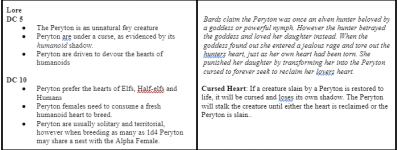gamerprinter
Mapper/Publisher
I do this too, but I use enjoy how Steven D. Russell (rest in peace) of Rite Publishing use to create 'new monsters', by taking an existing monster from a bestiary (he designed for PF 1.0), then make a some tweaks in it's abilities and mechanics, but then completely change it's description and lore. Like you take a peryton stat block, change a few of it's unique abilities and mechanics, replace or alter them, but make it black spotted, yellow giant six legged salamander immune to fire with poisonous skin, but in every way it just uses the peryton stat block. Players won't know what the creature, and you didn't have fully invent a new creature - just tweak the original, change it's appearance and name, and now it's a brand new creature. It may seem lazy, but it's creative trying to make a stat block work for something other than what it was originally designed to do.


